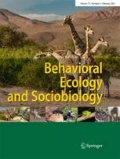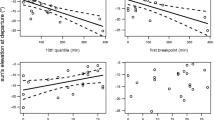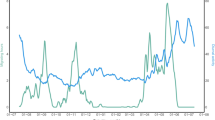Abstract
Quiescence is a period of inactivity that occurs before the onset of migratory activity in nocturnally migrating birds. This behavior has been observed in captive birds in migratory disposition, but its occurrence in free-ranging migratory birds has been documented only anecdotally, and causal factors and function(s), if any, are unknown. In this study, we documented and characterized quiescence in three migratory songbird species (red-eyed vireo [Vireo olivaceus], Swainson’s thrush [Catharus ustulatus], and wood thrush [Hylocichla mustelina]) by measuring movement and proportion of time spent inactive prior to departure from a stopover site during fall migration. Individuals of each species displayed a period of inactivity prior to departure which varied from less than 30 min to over 90 min with red-eyed vireos engaged in the longest, most pronounced quiescence. We also examined how quiescence was related to intrinsic and extrinsic factors known to influence the departure of migrating birds, and found some evidence for an effect of age and departure time but no effect of a migrant’s energetic condition, departure direction, atmospheric conditions around departure, or day of year on quiescence. Our novel application of an automated radiotelemetry system yielded a large amount of data to characterize quiescence in free-ranging migratory birds, and we provide guidance for future studies to tease apart the various causal factors and function(s) of this migratory behavior.
Significance statement
Quiescence is a poorly understood period of inactivity observed among captive and free-ranging migratory songbirds prior to the onset of nocturnal activity. Our novel use of automated radiotelemetry revealed quiescence among three intercontinental migratory songbirds. It also enabled us to ask how quiescence might be related to intrinsic and extrinsic factors known to influence the departure of migrating birds, and provided an opportunity to explore possible function(s), if any, of this intriguing behavior.






Similar content being viewed by others
References
Able KP (1972) Fall migration in coastal Louisiana and the evolution of migration patterns in the Gulf region. Wilson Bull 84:231–242
Agatsuma R, Ramenofsky M (2006) Migratory behaviour of captive white-crowned sparrows, Zonotrichia leucophrys gambelii, differs during autumn and spring migration. Behaviour 143(10):1219–1240. https://doi.org/10.1163/156853906778691586
Alerstam T, Lindström Å (1990) Optimal bird migration: the relative importance of time, energy, and safety. In: Gwinner E (ed) Bird migration. Springer, Berlin, pp 331–351. https://doi.org/10.1007/978-3-642-74542-3_22
Beauchamp G (2017) Does sun glare increase antipredator behavior in prey? J Avian Biol 48(4):591–595. https://doi.org/10.1111/jav.01154
Berthold P (1996) Control of bird migration. Chapman and Hall, London
Bolshakov CV (1992) Evening movements and the start of nocturnal migratory flight in the fieldfare (Turdus pilaris): preliminary results. Proc Zool Inst 247:18–42 [Russian with English summary]
Bolus R, Diehl R, Moore FR, Deppe J, Ward M, Smolinsky J, Zenzal TJ Jr (2017) Swainson’s thrushes do not show strong wind selectivity prior to crossing the Gulf of Mexico. Sci Rep 7(1):14280. https://doi.org/10.1038/s41598-017-14668-3
Celis-Murillo A, Benson TJ, Sosa-Lopez JR, Ward MP (2016) Nocturnal songs in a diurnal passerine: attracting mates or repelling intruders? Anim Behav 118:105–114. https://doi.org/10.1016/j.anbehav.2016.04.023
Chernetsov N (2012) Passerine migration: stopovers and flight. Springer, Berlin. https://doi.org/10.1007/978-3-642-29020-6
Chernetsov N, Kishkinev D, Kosarev V, Bolshakov C V (2011) Not all songbirds calibrate their magnetic compass from twilight cues: a telemetry study. J Exp Biol 214:2540–2543
Cochran WW, Mouritsen H, Wikelski M (2004) Migrating songbirds recalibrate their magnetic compass daily from twilight cues. Science 304:405–408
Deppe JL, Ward MP, Bolus RT, Diehl RH, Celis-Murillo A, Zenzal TJ Jr, Moore FR, Benson TJ, Smolinsky JA, Schofield LN, Enstrom DA, Paxton EH, Bohrer G, Beveroth TA, Raim A, Obringer RL, Delaney D, Cochran WW (2015) Negotiating the Gulf of Mexico: fat, weather and date affect migratory songbirds’ departure decisions, routes, and crossing times. Proc Natl Acad Sci U S A 112(46):E6331–E6338. https://doi.org/10.1073/pnas.1503381112
Diehl RH, Larkin RP (1998) Wingbeat frequency of two Catharus thrushes during nocturnal migration. Auk 115(3):591–601. https://doi.org/10.2307/4089408
Dodge S, Bohrer G, Weinzierl R, Davidson SC, Kays R, Douglas D, Cruz S, Han J, Brandes D, Wikelski M (2013) The environmental-data automated track annotation (Env-DATA) system: linking animal tracks with environmental data. Mov Ecol 1(1):3. https://doi.org/10.1186/2051-3933-1-3
Dodge S, Bohrer G, Bildstein K et al (2014) Environmental drivers of variability in the movement ecology of turkey vultures (Cathartes aura) in North and South America. Philos T Roy Soc B 369:1471–2970
Downey A (2013) Think Bayes. O'reilly Media, Sebastopol
Emlen S (1980) Decision making by nocturnal bird migrants: the integration of multiple cues. In: Nohring R (ed) Acta XVII International Ornithological Congress. Deutsche Ornithologen-Gesellschaft, Berlin, pp 553–560
Emlen ST, Emlen JT (1966) A technique for recording orientation of captive birds. Auk 83:361–367
Fuchs T, Haney A, Jechura TJ, Moore FR, Bingman V (2006) Daytime naps in night-migrating birds: behavioural adaptation to seasonal sleep deprivation in the Swainson’s thrush, Catharus ustulatus. Anim Behav 72(4):951–958. https://doi.org/10.1016/j.anbehav.2006.03.008
Fuchs T, Maury M, Moore FR, Bingman V (2009) Daytime micro-naps in a nocturnal migrants: an EEG analysis. Biol Lett 5(1):77–80. https://doi.org/10.1098/rsbl.2008.0405
Gelman A, Rubin DB (1992) Inference from interative simulation using multiple sequences. Stat Sci 7(4):457–511. https://doi.org/10.1214/ss/1177011136
Goymann W, Lupi S, Kaiya H, Cardinale M, Fusani L (2017) Ghrelin regulates migratory decisions in birds. Proc Natl Acad Sci USA 114:1946–1951. https://doi.org/10.1073/pnas.1619565114
Hebrard JJ (1971) The nightly initiation of passerine migrant in spring: a direct visual study. Ibis 113:8–18
Heise CD, Moore FR (2003) Age-related differences in foraging efficiency, molt, and fat deposition of gray catbirds prior to autumn migration. Condor 105(3):496–504. https://doi.org/10.1650/7183
Helms CW, Drury WH (1960) Winter and migratory weight and fat field studies on some North American buntings. Bird Band 31(1):1–40. https://doi.org/10.2307/4510793
Jones TM, Ward MP, Benson TJ, Brawn JD (2017) Variation in nestling body condition and wing development predict cause-specific mortality in fledgling dickcissels. J Avian Biol 48(3):439–447. https://doi.org/10.1111/jav.01143
Kays R, Tilak S, Crofoot M, Fountain T, Obando D, Ortega A, Wikelski M (2011) Tracking animal location and activity with an automated radio telemetry system in a tropical rainforest. Comput J 54(12):1931–1948. https://doi.org/10.1093/comjnl/bxr072
Kjos CG, Cochran WW (1970) Activity of migrant thrushes as determined by radio-telemetry. Wilson Bull 82:225–226
Levey DJ, Karasov WH (1994) Gut passage of insects by European starlings and a comparison with other species. Auk 111(2):478–481. https://doi.org/10.2307/4088614
Lindström Å (2003) Fuel deposition rates in migrating birds: causes, constraints, and consequences. In: Berthold P, Gwinner E, Sonnenschein E (eds) Avian migration. Springer, Berlin, pp 307–320. https://doi.org/10.1007/978-3-662-05957-9_21
Loria DE, Moore FR (1990) Energy demands of migration on red-eyed vireos, Vireo olivaceus. Behav Ecol Sociobiol 1(1):24–25. https://doi.org/10.1093/beheco/1.1.24
Louder MIM, Ward MP, Schelsky WM, Hauber ME, Hoover JP (2015) Out on their own: a test of adult-assisted dispersal in fledgling brood parasites reveals solitary departures from hosts. Anim Behav 110:29–37. https://doi.org/10.1016/j.anbehav.2015.09.009
Mesinger F, DiMego G, Kalnay E et al (2006) North American regional reanalysis. Bull Am Meteorol Soc 87:343–360
Moore FR (1987) Sunset and the orientation behavior of migrating birds. Biol Rev 62(1):65–86. https://doi.org/10.1111/j.1469-185X.1987.tb00626.x
Morton ML (1967) Diurnal feeding patterns in white-crowned sparrows Zonotrichia leucophyrs gambelii. Condor 69(5):491–512. https://doi.org/10.2307/1366149
Muheim R, Henshaw I, Sjӧberg S, Deutschlander ME (2014) BirdOriTrack: a new video-tracking program for orientation research with migratory birds. J Field Ornithol 85:91–105
Pakhomov A, Chernetsov N (2014) Early evening activity of migratory Garden Warbler Sylvia borin: compass calibration activity? J Ornithol 155:621–630
Palmgren P (1949) On the diurnal rhythm of activity and sleep in birds. Ibis 91:561–575
Parrish JD (1997) Patterns of frugivory and energetic condition in Neotropical landbirds during autumn migration. Condor 99(3):681–697. https://doi.org/10.2307/1370480
Piersma T (1998) Phenotypic flexibility during migration: optimization of organ size contingent on the risks and rewards of fueling and flight? J Avian Biol 29(4):511–520. https://doi.org/10.2307/3677170
Pyle P (1997) Identification guide to north American birds. Slate Creek Press, Bolinas
R Development Core Team (2011) R: a language and environment for statistical computing. R Foundation for Statistical Computing, Vienna http://www.R-project.org
Raim A (1978) A radio transmitter attachment for small passerine birds. Bird Band 49(4):326–332. https://doi.org/10.2307/4512391
Ramenofsky M, Agatsuma R, Ramfar T (2008) Environmental conditions affect the behavior of captive, migratory white-crowned sparrows. Condor 110:658–671
Rattenborg NC (2017) Sleeping on the wing. Interface Focus 7(1):20160082. https://doi.org/10.1098/rsfs.2016.0082
Rattenborg NC, Mandt BH, Obermeyer WH, Winsauer PJ, Huber R, Wikelski M, Benca RM (2004) Migratory sleeplessness in the white-crowned sparrow (Zonotrichia leucophrys gambelii). PLoS Biol 2(7):e212. https://doi.org/10.1371/journal.pbio.0020212
Sandberg R, Moore FR (1996) Migratory orientatation of red-eyed vireos, Vireo olivaceus, in relation to energetic condition and ecological context. Behav Ecol Sociobiol 39(1):1–10. https://doi.org/10.1007/s002650050261
Schmaljohann H, Rautenberg T, Muheim R, Naef-Daenzer B, Bairlein F (2013) Response of a freeflying songbird to an experimental shift of the light polarization pattern around sunset. J Exp Biol 216:1381–1387
Smith AD, McWilliams S (2014) What to do when stopping over: behavioral decisions of a migrating songbird during stopover are dictated by initial change in their body condition and mediated by key environmental conditions. Behav Ecol 25:1423–1435. https://doi.org/10.1093/beheco/aru148
Sjöberg S, Muheim R (2016) A new view on an old debate: type of cue-conflict manipulation and availability of stars can explain the discrepancies between cue-calibration experiments with migratory songbirds. Front Behav Neuosci 10:29
Smolinsky J, Diehl RH, Radzio T, Delaney DK, Moore FR (2013) Factors influencing the movement biology of migrant songbirds confronted with an ecological barrier. Behav Ecol Sociobiol 67(12):2041–2051. https://doi.org/10.1007/s00265-013-1614-6
Taylor PD, Crewe TL, Mackenzie SA, Lepage D, Aubry Y, Crysler Z, Finney G, Francis CM, Guglielmo CG, Hamilton DJ, Holberton RL, Loring PH, Mitchell GW, Norris DR, Paquet J, Ronconi RA, Smetzer JR, Smith PA, Welch LJ, Woodworth BK (2017) The motus wildlife tracking system: a collaborative research network to enhance the understanding of wildlife movement. Avian Cons and Ecol 12(1):8. https://doi.org/10.5751/ACE-00953-120108
Ward MP, Sperry JH, Weatherhead PJ (2013) Evaluation of automated eadio telemetry for quantifying movements and home ranges of snakes. J Herpetol 47(2):337–345. https://doi.org/10.1670/12-018
Ward MP, Alessi M, Benson TJ, Chiavacci SJ (2014) The active nightlife of diurnal birds: extraterritorial forays and nocturnal activity patterns. Anim Behav 88:175–184. https://doi.org/10.1016/j.anbehav.2013.11.024
Woodrey M, Moore FR (1997) Age-related differences in the stopover of fall landbird migrants on the coast of Alabama. Auk 114(4):695–707. https://doi.org/10.2307/4089289
Yong W, Moore FR (2005) Long-distance bird migrants adjust their foraging behavior in relation to energy stores. Acta Zool Sin 51:12–23
Zenzal TJ Jr, Fish AC, Jones TM, Ospina EA, Moore FR (2013) Observations of mortality and anti-predator behavior of ruby-throated hummingbirds (Archilocus colubris) during migratory stopover. Southeast Nat 12(4):N21–N25. https://doi.org/10.1656/058.012.0416
Acknowledgments
We thank our numerous field technicians at the University of Southern Mississippi (USM) Fort Morgan Peninsula Banding Station for their work and dedication as well as the USM radio tower crews and members of the USM Migratory Bird Research Group. We appreciate the Bon Secour National Wildlife Refuge for providing permission to conduct work on their property. We also thank Sarah Davidson and Rolf Weinzierl from Movebank.org, who assisted us in accessing atmospheric data. We thank Eben Paxton and two anonymous reviewers, who provided comments that substantially improved the quality of our paper. James Novak, Eric Bollinger, and Sean Peterson provided valuable feedback on the research and comments on earlier drafts. This work was supported by the National Science Foundation (IOS Award nos. 1146832, 1147096, and 1147022), National Geographic Society Committee on Research and Exploration (Award no. 8971-11), Eastern Illinois University (Research and Creative Activity Awards to JLD and LNS), University of Illinois Urbana-Champaign, and University of Southern Mississippi. TJZ was supported by a National Science Foundation GK-12 Program Award (no. 0947944). Any use of trade, firm, or product names is for descriptive purposes only and does not imply endorsement by the US Government.
Author information
Authors and Affiliations
Corresponding author
Ethics declarations
Ethical approval
All research activities involving animals were approved by the University of Southern Mississippi Institutional Animal Care and Use Committee (protocol no. 11092210), US Geological Survey Bird Banding Laboratory (permit no. 21221), and Bon Secour National Wildlife Refuge.
Conflict of interest
The authors declare that they have no conflict of interest.
Additional information
Communicated by W. Wiltschko
Rights and permissions
About this article
Cite this article
Schofield, L.N., Deppe, J.L., Diehl, R.H. et al. Occurrence of quiescence in free-ranging migratory songbirds. Behav Ecol Sociobiol 72, 36 (2018). https://doi.org/10.1007/s00265-018-2449-y
Received:
Revised:
Accepted:
Published:
DOI: https://doi.org/10.1007/s00265-018-2449-y




